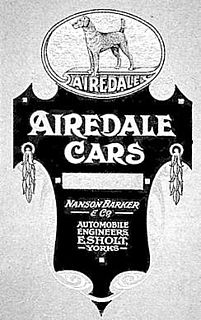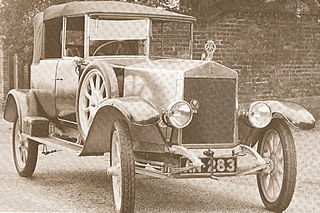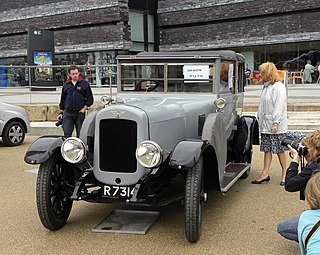
The Angus-Sanderson was an English automobile manufactured from 1919 to 1927 by Sir William Angus, Sanderson & Company Ltd.

The Angus-Sanderson was an English automobile manufactured from 1919 to 1927 by Sir William Angus, Sanderson & Company Ltd.
In concept it was something like the Bean and Cubitt; the idea was that one model would be mass-produced, as Ford had done so successfully. The 14 hp (10 kW) car was an assembly of proprietary parts, containing as it had a 2.3-litre side-valve engine from Tylor, a 3 speed gearbox and rear axle by Wrigley, Woodhead springs, and Goodyear wheels. One distinctive feature were disc wheels with a wavy pattern. [1] Indeed, the company made fewer of its own parts than any other British car company at the time. Approximately 3000 cars were produced but the car was expensive at £575.
"It came on the market in 1919 and by 1921 the impact of the Morris at undercut prices killed it off, although not before cars had been supplied to the Princess Royal and to S.F. Edge." [2]
The company was refinanced as Angus Sanderson (1921) Ltd and moved production from Birtley, County Durham to the Grahame-White aircraft factory in Hendon, Middlesex in 1921 and toyed with the idea of building a smaller 8 hp car in 1925 but few, if any were built. Neither of these actions nor a price reduction to £365 staved off the inevitable, and the company folded for good in 1927. [3]
The Aero Car was a British 5/7 hp flat twin-engine cyclecar manufactured from 1919 to 1920 by the Aerocar Engineering Company in Clapton, London. The engine was an air-cooled flat-twin built by Blackburne and the gearbox was a Sturmey-Archer. The body had a bullnose radiator and pointed tail.

The Airedale is an English automobile made in Esholt, near Shipley, West Yorkshire. It was the successor to the Tiny made by Nanson, Barker & Co in the same town from 1911 until the outbreak of war in 1914.

The Albatros was an English automobile manufactured in Croft Road, Coventry and founded in 1922 by H.T.W. Manwaring. The origin of the name is reputed to be derived from a play on the name of one Albert Ross, who was Manwaring's mentor and boss earlier in his career.

The Albert was a light car built by aircraft parts maker Adam, Grimaldi & Company and named after their Albert Embankment address. It was designed by A. O. Lord, creator of the later Loyd-Lord. It was produced from 1920 to 1924 in Vauxhall and later Chiswick, London.
The Ashton-Evans was an English car manufactured in Birmingham from 1919 to 1928 by Joseph Evans & Co of Liverpool Street Mills an engineering company who also made railway locomotives and aircraft parts. In 1919 a new company Ashton-Evans Motors Ltd was formed. The cars were designed by E Bailey who had been with Sunbeam and later J. Bedford.

Bean Cars was a brand of motor vehicles made in England by A Harper Sons & Bean, Ltd at factories in Dudley, Worcestershire, and Coseley, Staffordshire. The company began making cars in 1919 and diversified into light commercial vehicles in 1924. For a few years in the early 1920s Bean outsold Austin and Morris.

The Rolls-Royce Silver Ghost name refers both to a car model and one specific car from that series.

Coventry Premier Limited owned a British car and cyclecar manufacturing business based in Coventry from 1912 to 1923. It changed its name from Premier Cycles to Coventry Premier Ltd in November 1914.
The Xtra was an English three-wheel cyclecar launched at the Olympia show in November 1921 and built until 1924 by Xtra Cars, Ltd., of London Road, Chertsey, Surrey.

Chater-Lea was a British bicycle, car and motorcycle maker with a purpose-built five-storey factory in Banner Street, EC1, in the City of London and, from 1928, premises at Letchworth, Hertfordshire. It was founded by William Chater-Lea in 1890 to make bicycle frames and components. It made cars between 1907 and 1922 and motorcycles from 1903 to 1935. William died in 1927 and the business was taken over by his sons John and Bernard. After vehicle production finished, the company remained trading as a bicycle component maker and contract manufacturer until 1987. The company relaunched in 2017 as a maker of high end British manufactured bicycle components and launched its first new products in the summer of 2019.

The Austin Twelve is a motor car introduced by Austin in 1921. It was the second of Herbert Austin's post World War I models and was in many ways a scaled-down version of his Austin Twenty, introduced in 1919. The slower than expected sales of the Twenty brought about this divergence from his intended one-model policy. The Twelve was announced at the beginning of November 1921 after Austin's company had been in receivership for six months. The number twelve refers to its fiscal horse power (12.8) rather than its bhp which was 20 and later 27. The long-stroke engines encouraged by the tax regime, 72 x 102 later 72 x 114.5, had much greater low-speed torque than the bhp rating suggests.

Sheffield-Simplex was a British car and motorcycle manufacturer operating from 1907 to 1920 based in Sheffield, Yorkshire, and Kingston upon Thames, Surrey.
Grahame-White was an early British aircraft manufacturer, flying school and later manufacturer of cyclecars.
The CFB was a British four-wheeled cyclecar made between 1920 and 1921 by the CFB Car Syndicate Ltd of Upper Norwood, London. The company name stood for Charles Frederick Beauvais who later went on to build the Bow-V-Car and then joined coachbuilder New Avon Body Company designing bodies for Standard, Crossley Motors and others. Very few CFBs were made.
The Palmerston was a British car made by the Palmerston Motor Company based in Bournemouth, England between 1920 and 1923.
The Marlborough was a make of car sold on the British market between 1906 and 1926. For most of its life the cars were made by Malicet et Blin in France, but after World War I they were partially assembled (finished) in London and an increasing number of British parts used.

Austin Twenty is a large car introduced by Austin after the end of the First World War, in April 1919 and continued in production until 1930. After the Austin 20/6 model was introduced in 1927, the first model was referred to as the Austin 20/4.

The Warren-Lambert Engineering Co. Ltd. was a British automobile manufacturer that was established from 1912 to 1922 in Richmond, then in Surrey. A. Warren Lambert, was an agent for Morgan cars in Putney which he also raced. In 1912 he designed and started to manufacture a two-seat four-wheel cyclecar from premises in Uxbridge Road, Shepherd's Bush. It was well received and around 25 cars a week were being made.
The Enfield-Allday was an English car manufactured in Sparkbrook, Birmingham, from 1919 to 1924. The marque was created from the merged ranges of Alldays & Onions and Enfield and the Enfield Autocar Co Ltd.
The Lecoy was a short lived British 4-wheeled cyclecar made from 1921 to 1922 by the Lambert Engineering Co Ltd, St Hilda's Works, Northolt Road, Harrow, Middlesex.